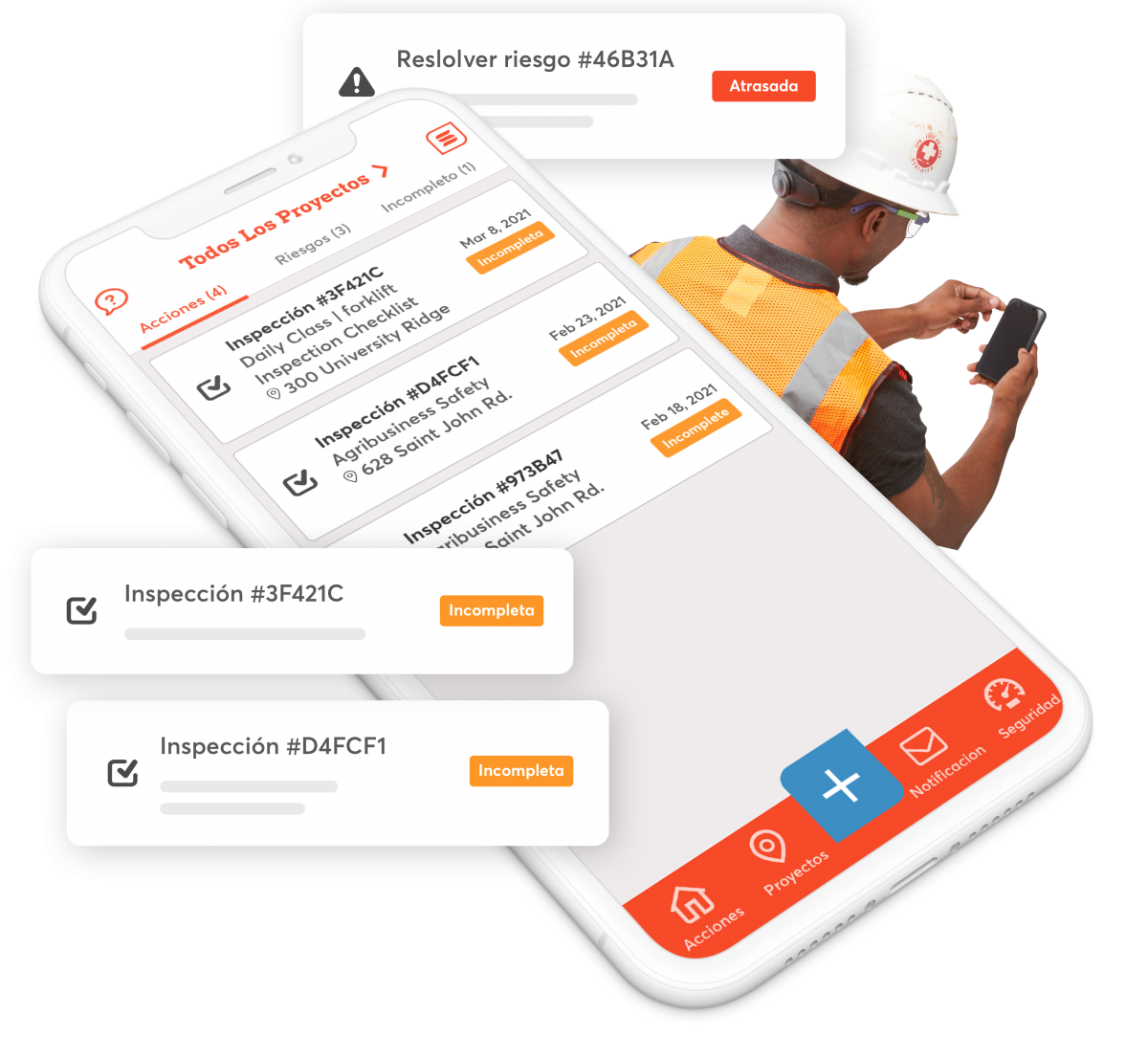Making your job site bilingual or multilingual can go a long way toward building a stronger safety culture and moving beyond compliance.
It’s not just about safety culture. A commitment to safety is particularly important on multilingual and multicultural job sites. For decades, studies have found higher rates of occupational injury among Hispanic workers in the United States compared to other groups of workers. Researchers theorize that language difficulties can be one of the obstacles in lowering rates of injury on construction sites.
What do you need to run a job site in more than one language? Here’s how you can get started in four steps.
4 Steps to Better Multilingual Safety Communication
Multilingual safety training and communication doesn’t require a complete overhaul of your safety program, but you will need to make some strategic decisions for implementation along the way.
Here’s how your company can transform from a monolingual site to a safer, multilingual site in four steps.

1. Decide Between Training in Their Native Language or Providing ESL
The first decision you’ll make relates to training. Training is the bedrock of both OSHA compliance and a safer workplace. OSHA also offers both requirements and supports for training language and vocabulary in its OSHA training standards (see more in the FAQs).
Usually, your company will choose between three multilingual training options:
- Commit to providing training in the employee’s native language or
- Choose an English as a second language program (or an equivalent if your primary language is not English) or
- Hire a translator or translator service to deliver training
Each of these allows you to meet your OSHA obligations. However, you may find that providing training in the employees’ native language delivers the best results.
When to Provide Training in Their Native Language
Some companies, particularly large, multinational organizations, believe that the role of the employee training provider isn’t to teach workers a language. They see the program as the means for providing vital job and safety information in a way the employee will find easy to digest and retain.
Providing training and documentation in an employee’s native language comes with some strategic benefits:
- It avoids ambiguities found in translation.
- It’s less cumbersome and time-consuming than using a translator.
- You avoid assuming an employee’s language proficiency and provide training in a vocabulary they understand (as per the OSHA rule).
- When employees can train and repeat information back in their native language, you are better able to test their comprehension and retention.
- Training services offered in their language are more likely to better navigate culture nuance and connect with the training audience.
Additionally, training in a workers’ native language helps cater to people of all different educational backgrounds.
It also sets your company up to train workers via American Sign Language (ASL) or Spanish Sign Language (Lengua de Signos Española or LSE), which further sets your company up for compliance with the Americans with Disabilities Act communication requirements.
When to Select an ESL Program
Many experts agree that training employees in their native language can produce the strongest results. However, some companies find there are practical constraints with that method.
They instead elect to provide ESL (or similar) courses to their workers and then to provide training in the vocabulary that matches their language level.
The ESL method is effective and it still fulfills the responsibility of training employees in a language they understand. It also has benefits such as: saving costs by avoiding the translation of major documents.
Your decision will likely reflect your workforce’s needs and operational requirements.
When to Provide a Translator
Finally, there is the option to use a translator to complete your training and documentation requirements. This is perhaps the third-best choice because it limits communication to only the time when a translator is available. However, if a translator is your only option, you may not need to foot the whole bill.
OSHA-funded programs may offer help with certain defined translation services. You can also use the OSHA website as a resource, which offers educational materials in English, Spanish, Vietnamese, and other languages.
2. Supplement Training with Multilingual Assets Tools
OSHA provides language obligations for your training requirements and some hazard communication programs. However, strong safety culture is inclusive, and to be inclusive, you need to provide a way for everyone to participate in a language they understand.
At a minimum, you’ll want multilingual safety assets, like images, videos, displays, and posters. Some of these will be available from federal OSHA or state agencies.
To see the greatest effect and minimize risk, you want to make your safety management program multilingual with the right safety management app or software.
Multilingual safety management tools can transform your safety program by:
- Making onboarding painless for all users
- Ensuring you get the best available safety data in real-time
- Fostering an inclusive culture
- Generating more worker involvement with safety
At Safesite, every team member can run the Safesite app in their preferred language, English, Spanish, French or Portuguese. All Safesite features are available in these languages, meaning workers can complete inspections, checklists, and audits seamlessly. You can also upload your own safety inspections, toolbox talks, and checklists in any language.

You can see the safety management dashboard in English and let your team run their app in English, Spanish, or a mix of the two.
3. Have Professional Interpreters on the Scene of Incidents
If you have a multilingual workplace, then you should also have multilingual incident reporting and investigations, particularly for OSHA recordable injures and especially in the event of an OSHA reportable injury or death.
Most of the time, you’ll complete this task through the use of professional interpreters to help you take statements from injured parties and witnesses.
Professional interpreters are on the scene in many high-stress scenarios, such as in critical care units at hospitals, on the ground at a crime scene, and in other places where it’s vital that all parties can communicate effectively and in real-time.

Having an interpreter on the scene after an incident can help you ensure that you collect accurate evidence for OSHA and your insurer and better help you identify the root cause of the incident.
<Want to write stronger incident reports? Get Safesite’s guide to writing an incident report, including incident report samples.
4. Invest in Diversity Training
The fourth step is a continued commitment to not only a multilingual workplace but a multicultural one.
Your multilingual communication goals should support and be sensitive to workers, particularly because there is still a stigma associated with a person’s language ability.
Diversity training can help you better determine the route you’ll take for delivering multilingual training and communication. How? The training will help you better understand the way culture frames the way we express ourselves, whether verbally, nonverbally, or through action.
Remember: Different labor cultures and traditions also reflect different working styles and habits, communication problems, and human relations. These human issues are at the center of your multilingual workplace. In fact, understanding these aspects of communication is equally — if not more — important as translation, interpreting, and providing suitable training.
FAQs
What Are the OSHA Training Requirements Around Language?
OSHA details the technical aspects of its training and hazard communication requirements within each standard. However, where many companies fall down in meeting OSHA training requirements is in the delivery.
OSHA requires employers with multilingual workforces to provide training in a “language and vocabulary” they will understand. The multilingual requirement applies to training requirements for:
- Agriculture
- Construction
- General Industry
- Maritime
The interpretation provided by OSHA makes the agency’s position clear. But fulfilling those requirements requires a thoughtful process, usually with several moving parts. After all, it’s not enough to download some of OSHA’s mandatory signs in Spanish. You need a multilingual workplace that goes beyond the core OSHA training requirements and includes training, documentation, and incident reporting.
Multilingual Safety Saves Lives
Multilingual safety helps break down the barriers that can lead to higher incident rates among minority groups, like Hispanic workers in construction. You don’t need to revamp your entire safety program to accomplish a multilingual workplace. You can take steps as simple as hiring an interpreter for OSHA training and incident investigations.
Are you ready to start building your multilingual safety program and go beyond compliance? Join us for a Safesite Demo to see how you could achieve a 57% reduction in workplace incidents and save 30% on health and safety costs.
